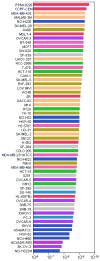Analysis of Food and Drug Administration-approved anticancer agents in the NCI60 panel of human tumor cell lines
- PMID: 20442306
- PMCID: PMC2868078
- DOI: 10.1158/1535-7163.MCT-10-0106
Analysis of Food and Drug Administration-approved anticancer agents in the NCI60 panel of human tumor cell lines
Erratum in
-
Correction.Am J Psychiatry. 2012 May;169(5):540. doi: 10.1176/appi.ajp.2012.169.5.540b. Am J Psychiatry. 2012. PMID: 22549216 Free PMC article. No abstract available.
Abstract
Since the early 1990s the Developmental Therapeutics Program of the National Cancer Institute (NCI) has utilized a panel of 60 human tumor cell lines (NCI60) representing 9 tissue types to screen for potential new anticancer agents. To date, about 100,000 compounds and 50,000 natural product extracts have been screened. Early in this program it was discovered that the pattern of growth inhibition in these cell lines was similar for compounds of similar mechanism. The development of the COMPARE algorithm provided a means by which investigators, starting with a compound of interest, could identify other compounds whose pattern of growth inhibition was similar. With extensive molecular characterization of these cell lines, COMPARE and other user-defined algorithms have been used to link patterns of molecular expression and drug sensitivity. We describe here the results of screening current Food and Drug Administration (FDA)-approved anticancer agents in the NCI60 screen, with an emphasis on those agents that target signal transduction. We analyzed results from agents with mechanisms of action presumed to be similar; we also carried out a hierarchical clustering of all of these agents. The addition of data from recently approved anticancer agents will increase the utility of the NCI60 databases to the cancer research community. These data are freely accessible to the public on the DTP website (http://dtp.cancer.gov/). The FDA-approved anticancer agents are themselves available from the NCI as a plated set of compounds for research use.
Conflict of interest statement
Figures







References
-
- Cragg GM. Paclitaxel (Taxol): a success story with valuable lessons for natural product drug discovery and development. Med Res Rev. 1998 Sep;18(5):315–31. - PubMed
-
- Holbeck SL, Sausville EA. The Proteasome and the COMPARE Algorithm. In: Adams J, editor. Proteasome Inhibitors in Cancer Therapy. Humana Press; 2004.
-
- Scudiero DA, Shoemaker RH, Paull KD, et al. Evaluation of a soluble tetrazolium/formazan assay for cell growth and drug sensitivity in culture using human and other tumor cell lines. Cancer Res. 1988 Sep 1;48(17):4827–33. - PubMed
-
- Holbeck SL. Update on NCI in vitro drug screen utilities. Eur J Cancer. 2004 Apr;40(6):785–93. - PubMed
-
- Sausville EA, Holbeck SL. Transcription profiling of gene expression in drug discovery and development: the NCI experience. Eur J Cancer. 2004 Nov;40(17):2544–9. - PubMed
Publication types
MeSH terms
Substances
Grants and funding
LinkOut - more resources
Full Text Sources
Other Literature Sources

